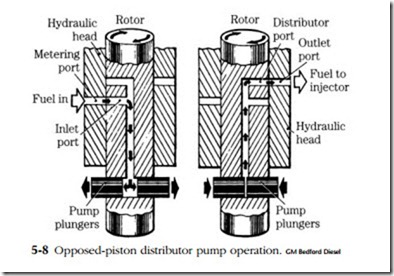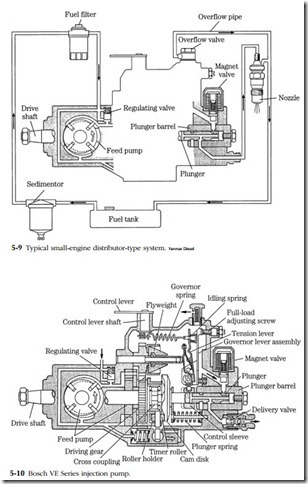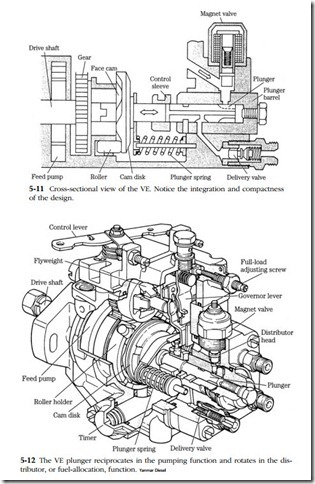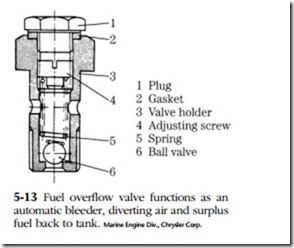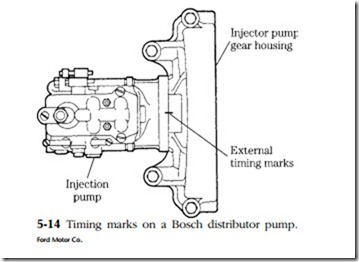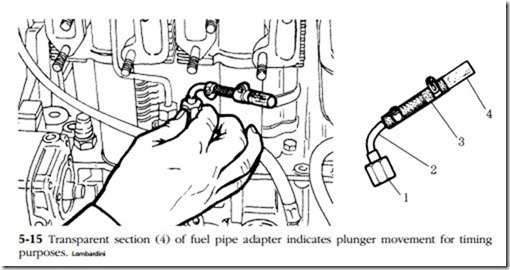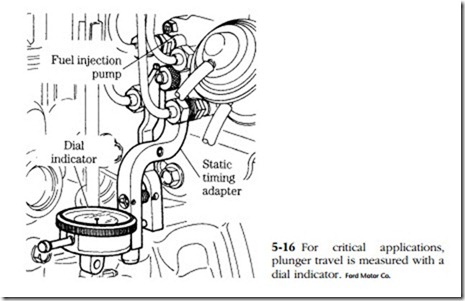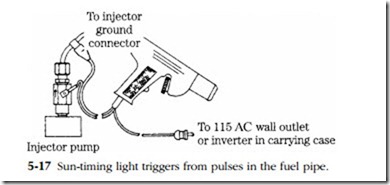Distributor pumps
The main technical advantage of distributor pumps is that each cylinder receives precisely the same amount of fuel since all cylinders feed from the same plunger or plunger set. And, as pointed out above, reducing the number of plungers, which must be lapped to angstrom tolerances, reduces costs.
Lucas/CAV
Figure 5-7 illustrates a CAV system for medium trucks. The engine-driven feed pump moves fuel from the tank to the filter and regulating valve. Fuel then passes to the transfer pump and, from there, to the inlet side of the distributor pump for pressurization and injection. As explained below, the regulating valve throttles the injection pump during low-speed operation. Surplus fuel returns to the tank through low-pressure lines.
A pair of cam-driven plungers, mounted on the pump rotor and turning with it, generate injector pressure (Fig. 5-8). During the inlet stroke the plungers move out- ward under pressure from fuel entering through the inlet (or metering) port. As the rotor continues to turn, the inlet port is blanked off by the rotor body and one of the outlet ports is uncovered.
As the outlet port is uncovered, the internal cam, acting through rollers, forces the plungers together. Fuel passes through the port for injection. Fuel that slips by the plungers returns to the filter.
The amount of fuel delivered per plunger stroke is determined by the regulating valve (upper right in Fig. 5-7) that is controlled by the accelerator pedal and the
centrifugal governor. At low engine speeds, the regulating valve limits the pressure of fuel going to the transfer pump and into the injection pump. Because the pump plungers are driven apart by incoming fuel, their outward displacement is determined by transfer-pump pressure. As engine speed and/or load increase, the regulating valve increases fuel pressure to force the pump plungers further apart. Unlike Bosch inline pumps, which throttle by varying the effective stroke, the Lucas/CAV unit varies the actual stroke.
Bosch VE
Nearly 50 million VE pumps have been produced since introduction in 1975 with applications ranging from fishing boats to luxury automobiles. Figure 5-9 sketches a basic installation, with filter, gravity-type water separator (sedimentor), fuel lines from the pump and injectors, and a solenoid-operated fuel shutoff (magnet) valve. Normally the fuel shutoff requires battery power to open; for marine applications the valve must be energized to close. This permits the engine to continue to run should the vessel lose electrical power.
The VE turns at half engine speed and is geared to a mechanical (shown in Fig. 5-10) or electronic governor. The rear half of the pump houses the vane-type transfer pump and regulator that supplies the high-pressure section with fuel at pressures ranging from 40 psi to 175 psi at full throttle. Vane-pump pressure also controls the hydraulic timer that advances injection with increased engine speeds.
A tongue-and-groove joint mates the rear half of the two-piece drive shaft with the forward, or plunger, half. This joint, which can be seen clearly in Fig. 5-11, permits the forward half of the shaft to move fore and aft as it rotates under the impetus of the face cam. The cam reacts against the housing through roller bearings, oriented as shown in Fig. 5-12.
A control sleeve regulates the effective stroke of the plunger, which discharges through delivery valves on the distributor head.
Injector pump service
Bleeding
Because surplus fuel recycles to the tank or filter through fuel overflow valves mounted at high points on pumps and injectors, a half-hour or so of operation is generally sufficient to purge the system of air bubbles (Fig. 5-13). More serious air intrusions require bleeding, using procedures described in Chap. 4 for conventional, pre-computer engines and elaborated upon in Chap. 6 for more modern engines.
Timing
Injection pumps have two provisions for synchronizing fuel delivery with piston movement. Timing marks on the drive gears establish the basic relationship. Elongated mounting-bolt holes, which allow the pump body to be rotated a few degrees, provide the fine adjustment. Reference marks stamped on the pump body and mounting flange enable the adjustment to be replicated (Fig. 5-14).
Transparent section (4) of fuel pipe adapter indicates plunger movement for timing purposes. Lombardini
Before removing a pump, bar the engine over until both valves on No. 1 cylinder close and the timing mark on the harmonic balancer or flywheel aligns with its pointer. This procedure indexes pump-gear timing marks for easy assembly. If the same pump is reinstalled, the reference marks on the pump body and flange should be valid. Substituting another pump puts the marks into question and the engine should be retimed, either statically or dynamically.
Static timing procedures vary enormously, but the purpose of the exercise is to synchronize the onset of fuel delivery with the piston in No. 1 cylinder. Depending upon engine make, model, and application, fuel should begin to flow anywhere from 8–22° btdc as the flywheel is barred over by hand.
Flywheels for small utility engines generally have two marks inscribed on their rims: one representing tdc and the other, always in advance of the first, indicating when fuel should begin to flow from No. 1 delivery valve. A convenient way to monitor fuel flow is to make up an adapter out of a length of clear plastic tubing and a delivery-valve fitting, as shown in Fig. 5-15. The mechanic slowly bars the engine over, while watching for the slightest rise in the fuel level. The onset of fuel move- ment should occur at the moment the timing mark aligns with its pointer. If tdc is passed and the plunger retreats, the flywheel must be turned back 15° or so to absorb gear lash, and the operation repeated.
Drive gears for Navistar (International) DT358 and its cousins have six timing marks. Which one to use depends upon the engine model and application. In a reversal of traditional practice, certain American Bosch pumps time to the end, rather than the onset, of fuel delivery. The delivery valve, which acts as a check valve, for No. 1 plunger must be disabled before timing.
Timing specifications for distributor pumps are often expressed in thousandths of an inch of plunger movement from bdc. Figure 5-16 illustrates the dial-indicator adapter that replaces the central bolt in the distributor head. Locating bdc—the precise moment when the plunger pauses at the bottom of its stroke—requires patience.
Once bdc is found, the mechanic zeros the gauge and bars the engine over in the normal direction of rotation to the appropriate crankshaft or harmonic-balancer mark. He then rotates the pump body as necessary to match lift with the published specification.
Dynamic timing, made with a strobe light while the engine ticks over at slow idle, compensates for pump-gear wear and other variables. It is the only way that van and other inaccessible engines can be timed.
The Sun timing light draws power from a wall outlet or, if equipped with an inverter, from the engine’s 12-V or 24-V batteries (Fig. 5-17). A transducer clamps over No. 1 fuel line to trigger the strobe when the injector opens and the sudden drop in fuel pressure contracts the line. The instrument also tracks how many crank- shaft degrees the timing advances as engine speed increases.
Unit injectors (UIs), which integrate the pump function with injection, are timed as described below.
Repair
Other than periodically checking the oil level for in-line pump reservoirs and adding rust inhibitor to the fuel before long-term storage, injector pumps require no special attention. When loss of pressure indicates that the pump has failed, the mechanic farms the unit out to a specialist for cleaning or repair.
While most mechanics would tackle Bosch VE, inline pumps are simple devices that can be opened for cleaning and elementary repairs. But the work requires patience and the highest possible levels of cleanliness. Plungers are lapped to their barrels and must be assembled as found. Nor should these sensitive parts be touched with bare fingers. Wear surgical gloves or use forceps. Tappets and other adjustable parts must be kept with their plungers. When disassembly entails loss of adjustment, the existing adjustments must be scribe marked. If at all possible, obtain a drawing of the pump before you begin.
Inline pumps come apart as follows:
• Unscrew the delivery valves mounted above each barrel and lay them out in sequence on the bench, which should be covered with newspaper to reduce the possibility of contamination.
• Most inline pumps incorporate a side cover for tappet access; others mount the individual plunger assemblies from above with studs. On those with side covers, rotate the camshaft to bring each tappet to the top of its stroke and shim the tappet. Withdraw the plungers from the top with the aid of a hooked wire or expansion forceps. Mark or otherwise identify the plungers for correct assembly.
• Inspect the lapped surfaces with a magnifying glass. Deep scores or pronounced wear marks mean that the pump has come to the end of its useful life. Over-tightening the delivery valves warps the barrels and produces uneven wear patterns. Water or algae in the fuel leave a dull, satiny finish on the rub- bing surfaces. Loss of the sharp edges on the helix profile upsets calibration.
• A plunger should fall of its own weight when the barrel is held 45° from vertical. Gummed or varnished plungers can make governor action erratic and accelerate wear on the helixes and rack.
• If you have the specifications, check the cam profile with an accurate (i.e., recently recalibrated) micrometer.
• Examine the rack teeth for wear. Figure 5-18 illustrates, in exaggerated fashion, the wear pattern. The rack should move on its bushings with almost no perceptible side or vertical play. Installation of new bushings requires a factory reamer.
Related posts:
Incoming search terms:
- lucas mechanical fuel injection
- distributor type fuel injection pump
- operation of distributor
- mechanical fuel-metering distributor how it work
- lucas pump regulating valve
- basic carm shaft
- how to check for no 1 port on distributor type pump
- distributor type pump cylinder ref marks
- carm shaft system
- vane type of fuel feed pump is used in conventional inline fuel injection pump

